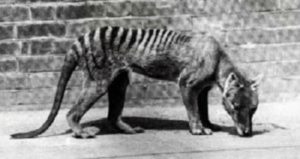
Australian researchers have launched a search for Tasmanian tiger—a species that is believed to have gone extinct about 80 years ago—after “plausible” possible sightings of the animal in north Queensland.
Tasmanian tiger, or thylacine as it is scientifically known, was the largest known carnivorous marsupial of modern times and was native to continental Australia, New Guinea and Tasmania. It featured striped lower back, and was the last existing member of Thylacinidae family. The last thylacine, named Benjamin, died in 1936 in captivity in Hobart zoo. According to the government, his keeper forgot to lock him in his hut, and then next morning he was found to be dead.
Past studies suggest that this creature was nocturnal, shy in nature, and looked similar to a medium-to-large-size dog. It was not a tiger, but was called tiger due to distinctive black stripes on its tail and lower back. It also featured an abdominal pouch (present in both sexes) and a stiff tail. It was able to hunt prey in extremely sparsely populated areas. Its nearest living relative is thought to be either Tasmanian devil or numbat.
Even before the arrival of the British in Australia mainland, Tasmanian tiger had become extremely rare, although it survived in Tasmania. However, during later period, its population reduced drastically due to intensive hunting, introduction of dogs, spread of disease, and habitat destruction.
Over the past decades, several incidents have been reported of sightings of big, dog-like animals in the wilds of Australia. The eyewitnesses said these creatures were neither foxes nor dingos.
In September last year, some videos were published claiming to show Tasmanian tigers lurking in the wilds in southern Australia. One video showed a blurred figure exploring a residential area in Adelaide Hills, South Australia. The other video showed a dog-sized animal with a stiff tail lurking in a field in Victoria.
Prof Bill Laurance from James Cook University says that he has talked to two people who claim of having seen an animal, potentially Tasmanian Tiger, in Cape York Peninsula. Professor Laurance will now lead the search across remote region in Australia’s biggest wilderness area.
He says all the potential sightings of this animal had been at night.
“In one case four animals were observed at close range – about 20 feet away – with a spotlight,” Prof Laurance said.
Descriptions of their behavior, eyes, shape and size did not match with attributes of other large species—wild dogs, dingoes, or feral pigs—that live in north Queensland.
Individuals who saw these creatures were “very nervous about relating their tales for fear of being branded kooks or fringe types”.
Sandra Abell, a researcher with James Cook University’s Centre for Tropical Environmental and Sustainability Science, says many people are now contacting the team to tell about possible sightings since the details of this project were published. Ms Abell is leading the field survey for search of Tasmanian tiger. According to her, more than 50 “camera traps” will be installed at different sites in Cape York Peninsula in coming months. The survey would also help the center in getting more information about the status of rare and endangered mammal species on the peninsula.
“It is a low possibility that we’ll find thylacines, but we’ll certainly get lots of data on the predators in the area and that will help our studies in general,” she said.
“I’m not ruling it out at all, but to actually get them on camera will be incredibly lucky.”